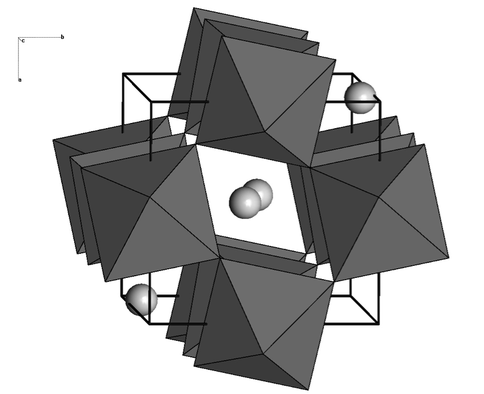2012 Annual Science Report
 University of Hawaii, Manoa
Reporting | SEP 2011 – AUG 2012
University of Hawaii, Manoa
Reporting | SEP 2011 – AUG 2012
Water in Planetary Interiors
Project Summary
The mineral MgSiO3 in the perovskite structure is thought to be the most abundant solid mineral phase in the Earth composing up to 45% of the mass of the planet. Because Earth’s oceans constitute only 0.023% of the planet’s mass, even small amounts of H substitution in the perovskite phase can control the H balance of a planet the size of Earth or Venus. There is considerable disagreement among previous workers about H solubility in the perovskite phase. We have synthesized samples of high-pressure mineral phases that are likely hosts for hydrogen, and thus water, in planetary interiors, and measured physical properties including crystal structure, density, elasticity, and electrical conductivity to see if there is evidence of deep hydration in the Earth.
Project Progress
We have synthesized samples of high-pressure mineral phases that are likely hosts for H, and thus water, in planetary interiors, and measured physical properties including crystal structure, density, elasticity, and electrical conductivity to see if there is evidence of deep hydration in the Earth. The nominally anhydrous minerals (those without H in the formula) are likely significant host phases for much of the H in and on the Earth and may control the H balance in terrestrial planets. Nominally hydrous phases may also play a significant role. Nominally anhydrous phases synthesized under hydrous conditions at Bayerisches Geoinstitut (University of Bayreuth, Germany) include olivine, wadsleyite, and ringwoodite (all (Mg,Fe)2SiO4), and clino-enstatite, majorite, akimotoite, and silicate perovskite (all (Mg,Fe)SiO3). Nominally hydrous phases include Phases B and D.
We have observed and documented the epitaxial relations and H distributions among coexisting olivine, wadsleyite, and clinopyroxene (Smyth et al., 2012). Ringwoodite is the spinel polymorph of Mg2SiO4 believed to be the major phase in the Earth at depths of 525 to 660 km. We measured the thermal expansion of hydrous ringwoodite (Ye at al., 2012), and sound velocities at elevated temperature and pressure (Mao et al., 2012).
Significant new results in 2012 include synthesis of new samples of hydrous akimotoite, perovskite, and majorite, all thought to be stable phases in Earth’s lower mantle. We observe potentially significant hydration in akimotoite (ilmenite-MgSiO3) and majorite (garnet-MgSiO3), but very low levels of hydration in perovskite-MgSiO3, thought to be the dominant phase in the lower mantle. We have also synthesized some Al-bearing perovskite-MgSiO3 to evaluate the effect of Al substitution on hydration.
The crystal structure of MgSiO3-perovskite. Mg2+ (sphere) is in irregular eight-coordination with oxygen. Si+4 is in octahedral (six) coordination. H solubility in the structure appears to be enhanced by Al substitution for Si in the octahedral site.
Publications
-
Mao, Z., Lin, J-F., Jacobsen, S. D., Duffy, T. S., Chang, Y-Y., Smyth, J. R., … Prakapenka, V. B. (2012). Sound velocities of hydrous ringwoodite to 16GPa and 673K. Earth and Planetary Science Letters, 331-332, 112–119. doi:10.1016/j.epsl.2012.03.001
-
Ye, Y., Brown, D. A., Smyth, J. R., Panero, W. R., Jacobsen, S. D., Chang, Y-Y., … Frost, D. J. (2012). Compressibility and thermal expansion of hydrous ringwoodite with 2.5(3) wt% H2O. American Mineralogist, 97(4), 573–582. doi:10.2138/am.2012.4010
-
Ye, Y., Smyth, J. R., Jacobsen, S. D., & Goujon, C. (2012). Crystal chemistry, thermal expansion, and Raman spectra of hydroxyl-clinohumite: implications for water in Earth’s interior. Contrib Mineral Petrol, 165(3), 563–574. doi:10.1007/s00410-012-0823-8
-
Ye, Y., Smyth, J. R., Jacobsen, S. D., Panero, W. R., Brown, D. A., Katsura, T., … Goujon, C. (2013). Crystal structure, Raman and FTIR spectroscopy, and equations of state of OH-bearing MgSiO3 akimotoite. Contrib Mineral Petrol, 166(5), 1375–1388. doi:10.1007/s00410-013-0933-y
- Smyth, J.R., Miyajima, N., Hillebrand, E., Huss, G., Rubie, D.C. & Frost, D.J. (2012). Olivine-wadsleyite-pyroxene topotaxy: element and volatile distributions at the 410 km discontinuity. Physics of the Earth and Planetary Interiors, 200: 85-91.
-
PROJECT INVESTIGATORS:
-
PROJECT MEMBERS:
Joseph Smyth
Project Investigator
Gary Huss
Co-Investigator
Lydia Hallis
Postdoc
-
RELATED OBJECTIVES:
Objective 1.1
Formation and evolution of habitable planets.
